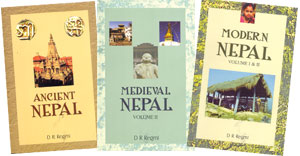 Dilli Raman Regmi's massive history of Nepal from antiquity up to 1814 is itself of historic importance. Regmi was the first scholar to explore in elaborate detail the political, economic, social, and cultural aspects of Nepal in antiquity and medieval times and help make the case for Nepal as an independent entity.
Dilli Raman Regmi's massive history of Nepal from antiquity up to 1814 is itself of historic importance. Regmi was the first scholar to explore in elaborate detail the political, economic, social, and cultural aspects of Nepal in antiquity and medieval times and help make the case for Nepal as an independent entity.
Nepal scholars and enthusiasts will be pleased to know that New Delhi-based publishers Rupa & Co, in association with the Dr Dilli Raman Regmi Foundation in Kathmandu, have re-issued this seminal work in four parts-Ancient Nepal, Medieval Nepal Vols I and II, Modern Nepal Vols I and II. The reprint rolls the four volumes of Medieval Nepal into two volumes and the two of Modern Nepal into one.
Nepal's changing political scenario has affected interpretive and analytical approaches to history. After the fall of Rana rule in 1951 local and foreign scholars started undertaking exploratory and analytical research on Nepal's history. Today, historians can write frankly without fear of censorship or retribution and there are now new authoritative scholarly texts. But first there was DR Regmi.
Regmi started writing about Nepali history, politics, and economics in 1942, Most of his books were published by Firma KL Mukhopadhyaya, Calcutta. Ancient Nepal was first published in 1960 and enlarged in 1969. The author's meticulous research results in a political history of the Licchavi period's kings, polity, economy, and foreign policy, and society, and analytical descriptions of the culture, art, architecture, and sculpture of the time.
Regmi's assessment of the importance and utility of various source materials connected with this period of Nepal's history remains valuable. The two volumes of Medieval Nepal present a short history of the kingdoms of the time covering the areas including and around present-day Nepal. Regmi details the Khasa Malla kingdom extending from Garhwal (in present-day India) in the west, to the Trisuli in the east, Manosarovar and Taklakhar area (in present-day Tibet) in the north, and the tarai in the south.
The Karnata kingdom with Simroangarch as capital extended from the Mahabharat range in the north, to Bodh Gaya and the Ganga in the south, the Gandaki in the west, and the Kosi in the east. Also covered are the the baise principalities in the Karnali basin area, the chaubise in the Gandaki basin area, and the three Sena kingdoms of the eastern Nepal. Finally, there are the three Malla kingdoms that ruled from the three towns of Kathmandu Valley from the Trisuli in the west, the Dudh Kosi in the east, Kuti and Kerong (present-day Tibet) in the north, and to the Mahabharat range in the south.
Regmi writes in detail about the genealogical political history of the Malla dynasty of the Nepal Mandala and presents the first comprehensive assessment of their economic, administrative, socio-cultural, and artistic systems. Regmi's work is critiqued as Kathmandu Valley-centric, a leaning he would not deny. He believed that the Valley, the original 'Nepal', was "the centre of learning" in medieval times.
In 1961 Regmi wrote a brief volume on early modern Nepal, based on contemporary epigraphic evidence. Fourteen years later, he published the two volumes of Modern Nepal, covering political history up to 1814 with detailed explanations, exhaustive information, and comprehensive analytical assessments of specific events. The re-issue contains new information and analysis. The revised volumes bear testimony to Regmi's extensive research, but do not contain his trademark analysis of the social, economic, administrative, and cultural aspects of the era.
Nepal's history was, until DR Regmi, written and interpreted by foreign scholars in terms of it being a small country sandwiched between two massive ones. In his histories, Regmi makes a strong case to counter that perception.
Regmi's academic contributions, in particular, his history books suffer from certain limitations. Since he was not an epigraphist, he had to depend upon the findings and interpretations of others. At the time that he was writing, there had been very limited archaeological excavations and explorations carried out to interpret Nepal's history. Regmi's political career has had positive and negative influences on his scholarly work.
From the present day perspective, some of his views can seem obsolete or erroneous. Yet, it remains rewarding to consult these books as a product of their time-and of an indefatigable scholar. The publishers of this welcome re-issue seem to have inexplicably omitted the fourth volume of Medieval Nepal, part IV. Also, a new edition, with corrections and updated by contemporary scholars would be much appreciated.
TR Vaidya is professor of history and vice-chancellor of Lumbini Buddha University.


